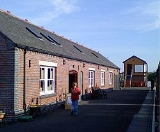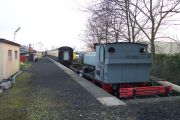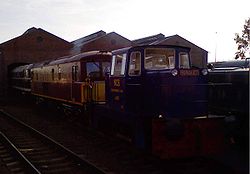
Chasewater Railway
Encyclopedia
The Chasewater Railway is a former colliery railway running round the shores of Chasewater
in Staffordshire
, England
. It is now operated as a heritage railway
.
The line is approximately two miles in length, contained entirely within Chasewater Country Park. The route, which forms a horse-shoe shape around the lake, passes through heathland, including a Site of Special Scientific Interest
, and passes over a one-quarter mile long causeway
.
to serve the coalfields of the Cannock Chase
area. The exchange sidings, where the colliery line connected with the Midland Railway
, were situated about a quarter of a mile north of the current Brownhills West Station.
Significant changes happened in 2002/2003 caused by the closure of the old Brownhills
station, due to the building of the M6 Toll
motorway. This led to the rebuilding of Brownhills West with significantly improved facilities, including a new carriage shed and heritage centre, and completion of the Chasetown
section of the line (the 'Chasetown Extension Railway' between Chasewater Heaths and Chasetown Church Street).
and diesel locomotive
s of mostly industrial origin, many with local industrial connections. Passengers are conveyed in ex-DMU cars
and British Railways Mark 1
coaches, as well as brake van
s on gala days. In recent years the railway has also played host to various guest steam locomotives from other lines.
The railway also owns various vintage carriages, some dating back over a century. These, as well as other rolling stock, are accommodated in the newly completed carriage shed.


Many other ex-industrial diesel
and petrol locomotives, in various stages of restoration, are also present at Brownhills West.
Chasewater
Chasewater is a 3-square-kilometre reservoir in the parish of Burntwood, in the district of Lichfield, Staffordshire, England. Originally known as Norton Pool, it was created as a canal feeder reservoir in the 18th Century and remains the largest in use in the region today.-History:Work on...
in Staffordshire
Staffordshire
Staffordshire is a landlocked county in the West Midlands region of England. For Eurostat purposes, the county is a NUTS 3 region and is one of four counties or unitary districts that comprise the "Shropshire and Staffordshire" NUTS 2 region. Part of the National Forest lies within its borders...
, England
England
England is a country that is part of the United Kingdom. It shares land borders with Scotland to the north and Wales to the west; the Irish Sea is to the north west, the Celtic Sea to the south west, with the North Sea to the east and the English Channel to the south separating it from continental...
. It is now operated as a heritage railway
Heritage railway
thumb|right|the Historical [[Khyber train safari|Khyber Railway]] goes through the [[Khyber Pass]], [[Pakistan]]A heritage railway , preserved railway , tourist railway , or tourist railroad is a railway that is run as a tourist attraction, in some cases by volunteers, and...
.
The line is approximately two miles in length, contained entirely within Chasewater Country Park. The route, which forms a horse-shoe shape around the lake, passes through heathland, including a Site of Special Scientific Interest
Site of Special Scientific Interest
A Site of Special Scientific Interest is a conservation designation denoting a protected area in the United Kingdom. SSSIs are the basic building block of site-based nature conservation legislation and most other legal nature/geological conservation designations in Great Britain are based upon...
, and passes over a one-quarter mile long causeway
Causeway
In modern usage, a causeway is a road or railway elevated, usually across a broad body of water or wetland.- Etymology :When first used, the word appeared in a form such as “causey way” making clear its derivation from the earlier form “causey”. This word seems to have come from the same source by...
.
History
Prior to preservation, the line was part of the network operated by the NCBNCB
NCB is a three-letter abbreviation for:* Balanced Noise Criterion, a function for measuring noise levels* Narcotics Control Bureau - the Indian drug enforcement agency.* National Cargo Bureau* Nanyang Commercial Bank...
to serve the coalfields of the Cannock Chase
Cannock Chase
Cannock Chase is a mixed area of countryside in the county of Staffordshire, England. The area has been designated as the Cannock Chase Area of Outstanding Natural Beauty. The Chase gives its name to the Cannock Chase local government district....
area. The exchange sidings, where the colliery line connected with the Midland Railway
Midland Railway
The Midland Railway was a railway company in the United Kingdom from 1844 to 1922, when it became part of the London, Midland and Scottish Railway....
, were situated about a quarter of a mile north of the current Brownhills West Station.
Significant changes happened in 2002/2003 caused by the closure of the old Brownhills
Brownhills
Brownhills is a town in the West Midlands, England. Located on the edge of Cannock Chase near the large artificial lake Chasewater, it is north-east of Walsall and a similar distance south-west of Lichfield. It is part of the Metropolitan Borough of Walsall and the Aldridge-Brownhills...
station, due to the building of the M6 Toll
M6 Toll
The M6 Toll , connects M6 Junction 4 at the NEC to M6 Junction 11A at Wolverhampton with of six-lane motorway. The weekday cash cost is £5.30 for a car and £10.60 for a HGV...
motorway. This led to the rebuilding of Brownhills West with significantly improved facilities, including a new carriage shed and heritage centre, and completion of the Chasetown
Chasetown
Chasetown is an area in the town of Burntwood, and is split between the civil parishes of Burntwood and Hammerwich in Staffordshire, England.Chasetown began as a coal mining village in the mid-18th century, at first known simply as Cannock Chase...
section of the line (the 'Chasetown Extension Railway' between Chasewater Heaths and Chasetown Church Street).
Stations
- Brownhills WestBrownhills West railway stationBrownhills West railway station is a heritage railway station on the Chasewater Railway in Staffordshire. It is the western terminus of the Chasewater Railway. The present facilities were constructed after the original station stood in the way of the M6 Toll motorway....
- Norton Lakeside HaltNorton Lakeside Halt railway stationNorton Lakeside Halt railway station is a heritage railway station on the Chasewater Railway in Staffordshire. It is a simple halt, consisting of a single platform, with no station building and no loops or sidings. It is situated in Chasewater Country Park. To the west is Brownhills West railway...
- Chasewater HeathsChasewater Heaths railway stationChasewater Heaths is a heritage railway station on the Chasewater Railway in Burntwood, Staffordshire. It has station building facilities, including a cafe; and a recently rebuilt signal box...
(adjacent to BurntwoodBurntwoodBurntwood is a town in Staffordshire, England, lying in the Cannock Chase area approximately west of Lichfield. The town had a population of 25,674 at the time of the 2001 census and forms part of Lichfield district. The town forms one of the largest urbanised parishes in England. Samuel Johnson...
bypass) - Chasetown Church StreetChasetown (Church Street) railway stationChasetown is a heritage railway station on the Chasewater Railway. It is the north-eastern terminus of the line and consists of a single platform with a run-round loop. The station was constructed in 2000 as part of the extension of the line, that was undertaken following the construction of the...
Rolling stock
The railway is home to a collection of steamSteam locomotive
A steam locomotive is a railway locomotive that produces its power through a steam engine. These locomotives are fueled by burning some combustible material, usually coal, wood or oil, to produce steam in a boiler, which drives the steam engine...
and diesel locomotive
Diesel locomotive
A diesel locomotive is a type of railroad locomotive in which the prime mover is a diesel engine, a reciprocating engine operating on the Diesel cycle as invented by Dr. Rudolf Diesel...
s of mostly industrial origin, many with local industrial connections. Passengers are conveyed in ex-DMU cars
Diesel multiple unit
A diesel multiple unit or DMU is a multiple unit train consisting of multiple carriages powered by one or more on-board diesel engines. They may also be referred to as a railcar or railmotor, depending on country.-Design:...
and British Railways Mark 1
British Railways Mark 1
British Railways Mark 1 was the family designation for the first standardised designs of railway carriages built by British Railways. Following nationalisation in 1948, BR had continued to build carriages to the designs of the "Big Four" companies , and the Mark 1 was intended to be the...
coaches, as well as brake van
Brake van
Brake van and guard's van are terms used mainly in the UK, Australia and India for a railway vehicle equipped with a hand brake which can be applied by the guard...
s on gala days. In recent years the railway has also played host to various guest steam locomotives from other lines.
The railway also owns various vintage carriages, some dating back over a century. These, as well as other rolling stock, are accommodated in the newly completed carriage shed.
Locomotives


- Steam Locomotives
- Hawthorn Leslie 0-4-0ST "Asbestos" (Currently operational)
- W.G. BagnallW.G. BagnallW. G. Bagnall was a locomotive manufacturer from Stafford, England. It was founded in 1875 by William Gordon Bagnall and ceased trading in 1962 when it was taken over by English Electric Co Ltd. The company was located at the Castle Engine Works, in Castle Town, Stafford...
0-4-0ST No. 2648 "Linda" (Currently operational) - SentinelSentinel Waggon WorksSentinel Waggon Works Ltd was a British company based in Shrewsbury, Shropshire that made steam-powered lorries, railway locomotives, and later, diesel engined lorries and locomotives.-Alley & MacLellan, Sentinel Works, Jessie Street Glasgow:...
0-4-0VBT (Currently under overhaul) - Andrew Barclay 0-4-0ST N.C.B 1964 (Currently operational)
- Andrew Barclay 0-4-0ST No. 1223 "Colin McAndrew (Currently operational)
- NeilsonNeilson and CompanyNeilson and Company was a locomotive manufacturer in Glasgow, Scotland.The company was started in 1836 at McAlpine Street by Walter Neilson and James Mitchell to manufacture marine and stationary engines...
0-4-0ST, built 1882. (Currently stored) - Hudswell ClarkeHudswell ClarkeHudswell, Clarke and Company Limited was an engineering and locomotive building company in Jack Lane, Hunslet, Leeds, West Yorkshire, England.-History:...
0-6-0T No. S100. (Currently under restoration) - Peckett and SonsPeckett and SonsPeckett and Sons was a locomotive manufacturer at the Atlas Works in St. George, Bristol, England.-Fox, Walker and Company:The company began trading in 1864 at the Atlas Engine Works, St. George, Bristol, as Fox, Walker and Company, building four and six-coupled saddle tank engines for industrial use...
0-4-0ST, built 1902 (Currently under restoration) - Hudswell ClarkeHudswell ClarkeHudswell, Clarke and Company Limited was an engineering and locomotive building company in Jack Lane, Hunslet, Leeds, West Yorkshire, England.-History:...
0-6-0ST, No.431. (Currently stored) - Hunslet Engine Co. 0-6-0ST "Rhos". (Currently stored)
- Andrew Barclay 0-4-0ST No. 2343. (Currently stored)
- Diesel Locomotives
- RustonRuston (engine builder)Ruston & Hornsby, later known as Ruston, was an industrial equipment manufacturer in Lincoln, England, the company's history going back to 1840. The company is best known as a manufacturer of narrow and standard gauge diesel locomotives and also of steam shovels. Other products included cars, steam...
0-4-0 diesel-electric - North British Locomotive CompanyNorth British Locomotive CompanyThe North British Locomotive Company was created in 1903 through the merger of three Glasgow locomotive manufacturing companies; Sharp Stewart and Company , Neilson, Reid and Company and Dübs and Company , creating the largest locomotive manufacturing company in Europe.Its main factories were...
0-4-0 "D2911" (Currently stored, pending repairs) - BR Class 08British Rail Class 08The British Rail Class 08 is a class of diesel-electric shunting locomotive. From 1953 to 1962, 996 locomotives were produced, making it the most numerous of all British locomotive classes....
no D3249/08 359
- Ruston
Many other ex-industrial diesel
Diesel locomotive
A diesel locomotive is a type of railroad locomotive in which the prime mover is a diesel engine, a reciprocating engine operating on the Diesel cycle as invented by Dr. Rudolf Diesel...
and petrol locomotives, in various stages of restoration, are also present at Brownhills West.
- Diesel Multiple Units
- BR Class 101British Rail Class 101The British Rail Class 101 diesel multiple units were built by Metro-Cammell at Washwood Heath in Birmingham from 1956 to 1959, following construction of a series of prototype units. This class proved to be the most successful and longest-lived of all BR's First Generation DMUs, with the final five...
Metro Cammell "Daisy" nos 53160 and 53164 (Currently being repaired)
- BR Class 101
- Diesel Multiple Unit Centre Cars
- BR Class 127British Rail Class 127The British Rail Class 127 diesel multiple units were built by BR Derby in 1959. Thirty 4-car units were built, formed of two outer driving motor vehicles, sandwiching two intermediate trailers which were classified class 186...
no. 59603 - BR Class 116British Rail Class 116The British Rail Class 116 diesel multiple units were built by BR Derby from 1957 to 1961.-Regular use:These units stayed in regular service until 1990, when they began to be withdrawn from traffic. They were replaced on regional services by the new "Sprinter" derivative units, or by Class 323...
no. 59444
- BR Class 127

